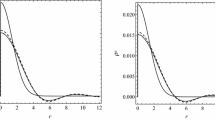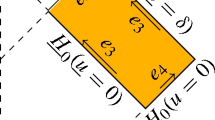Abstract
The contemporary notion of black hole originates in Oppenheimer and Snyder’s 1939 article “On Continued Gravitational Contraction” (Phys. Rev. 56:455, 1939). In particular, Penrose (Phys. Rev. Lett. 14:57, 1965) showed that their metric gave rise to trapped surfaces, that is regions of space from which no light rays can escape, and proved that within such surfaces black-hole formation is inevitable. Section “No trapped surfaces” of this article shows that a simple modification of the Oppenheimer-Snyder metric, fully consistent with General Relativity, may be made, so that all radial light rays originating in the interior escape to the exterior. There is no trapped surface and no black hole; on the contrary there is a stable end state with finite density, contained within a sphere of Schwarzschild radius. Implications for the interpretation of General Relativity, and also for experimental observation of supermassive objects and the Event Horizon Telescope project, are discussed in the concluding section.

Similar content being viewed by others
Notes
In terms of (R,r) the tensor g appears to be discontinuous at R=1, but this discontinuity is removed when we take account of the different definitions of t(R,r) in the two regions. We identified incorrectly this discontinuity as the “fatal error” of OS in earlier articles (Marshall 2007, 2009; Marshall and Wallis 2010). The real fatal error of OS was their imposition of (7).
OS showed, from analysis of the mass tensor, that for t→−∞ the mass density is uniform in R<R 0.
References
Babak, S.V., Grishchuk, L.P.: Phys. Rev. D 61, 024038 (1999)
Einstein, A.: Sitz.ber. Preuss. Akad. Wiss. Berl. Philos.-Hist. Kl. 1, 154–167 (1918)
Hawking, S.W., Ellis, G.F.R.: The Large Scale Structure of Space-Time. Cambridge U. P., Cambridge (1973)
Logunov, A.A.: Theory of Gravity. Nauka, Moscow (2001)
Logunov, A.A., Mestvirishvili, M.A.: Theor. Math. Phys. 170(3), 413–419 (2012)
Marshall, T.W.: Gravitational waves versus black holes. arXiv:0707.0201 (2007)
Marshall, T.W.: The gravitational collapse of a dust ball. arXiv:0907.2339 (2009)
Marshall, T.W.: Fields tell matter how to move. arXiv:1103.6168 (2011)
Marshall, T.W., Wallis, M.K.: J. Cosmol. 6, 1473–1484 (2010)
Mitra, A.: Astrophys. Space Sci. 332, 43–48 (2011)
Oppenheimer, J.R., Snyder, H.: Phys. Rev. 56, 455 (1939)
Oppenheimer, J.R., Volkoff, G.: Phys. Rev. 54, 540 (1939)
Penrose, R.: Phys. Rev. Lett. 14, 57 (1965)
Thorne, K.S.: Black Holes and Time Warps. Norton, New York (1994)
Weinberg, S.: Gravitation and Cosmology. Wiley, New York (1972)
Acknowledgements
I wish to express my thanks to Dr Max Wallis for valuable discussion and suggestions.
Author information
Authors and Affiliations
Corresponding author
Rights and permissions
About this article
Cite this article
Marshall, T.W. Gravitational collapse without black holes. Astrophys Space Sci 342, 329–332 (2012). https://doi.org/10.1007/s10509-012-1170-y
Received:
Accepted:
Published:
Issue Date:
DOI: https://doi.org/10.1007/s10509-012-1170-y




